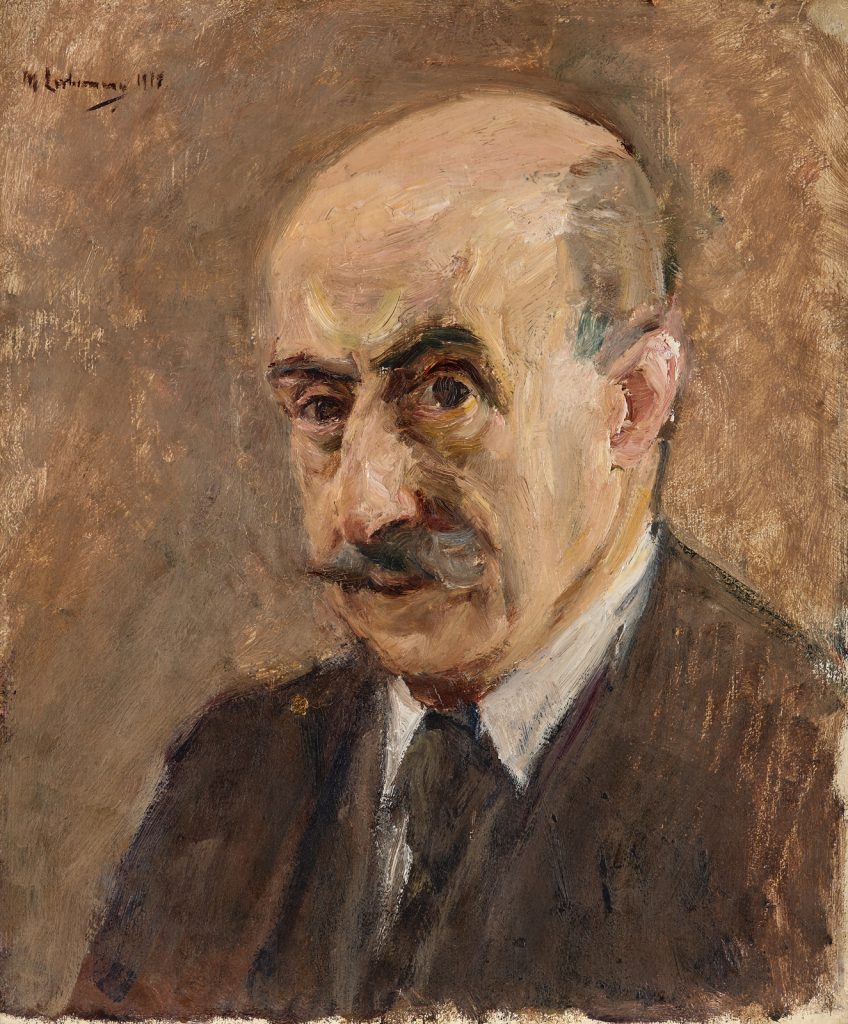Max Liebermann
(1847 - Berlin - 1935)
Self-Portrait, 1911
Oil on panel, 37.2 x 30.8 cm
Signed and dated upper left M. Liebermann 1911
Provenance:
Paul Cassirer, Berlin (1914)
Galerie Caspari, Munich (the Paul Cassirer Archive in Zurich holds a contemporary photograph bearing this inscription)
Josef Stransky, New York (1916)
Galerie Gebhardt, Munich
Georg Schäfer private collection, Schweinfurt, inv. SGS 1295 (acquired in 1953)
German private collection
Literature:
Modern Paintings by German and Austrian Masters. Collected and catalogued by Josef Stransky, New York 1916, pp. 225-6, repr. p. 227
Matthias Eberle, Max Liebermann, Werkverzeichnis der Gemälde und Ölstudien, Munich 1995, II, no. 1911/4, repr. p. 803
Max Liebermann’s preoccupation as a self-portraitist – and as a painter of portraits in general – did not really emerge until late in life.[1] Earlier in his career his attempts at portraiture were unenthusiastically received and less than successful. One example is his first commissioned portrait – the controversial Portrait of Carl Friedrich Petersen, Lord Mayor of Hamburg, painted in 1891. Petersen himself delivered a damning verdict and the portrait was subjected to a barrage of criticism. Only after 1907 did Liebermann’s work see a thematic shift when he began to reorientate himself towards portraiture. He received a flurry of commissions and advanced to be a highly sought-after portraitist of figures prominent in Berlin high society. His sitters included the writer Gerhart Hauptmann, the publisher and gallerist Bruno Cassirer and Germany’s President, Paul von Hindenburg.
No self-portraits from Liebermann’s early years have come to light, apart from a portrayal of himself in the guise of a cook depicted in a kitchen still life. It dates from 1873. The first true self-portrait portrays him at the age of fifty-five, by which time he was a much-feted artist and prominent establishment figure in Berlin artistic circles. But even this would not have come about at all without prompting from elsewhere: the client commissioning the self-portrait was the Uffizi Gallery in Florence.
In later years Liebermann concentrated on self-portraiture, producing no less than seventy self-portraits in the period between 1902 and his death in 1935. This constitutes a major body of work, in the context of his entire œuvre. His output was prodigious – particularly in the years 1911-13, 1917 and 1922. The art historian Hermann Kunisch suggests that at both a public and a private level these may have been particularly turbulent years. Questioning his own being, searching for his own identity took on even greater urgency, to counter a surge of extreme anxiety and perhaps to find reassurance and self-affirmation of his own innermost being.[2] The present self-portrait was executed in 1911 when Liebermann was sixty-four.[3] He portrays himself in three-quarter profile to the left before a dark background. His gaze is firm and self-confident – a man of the world wearing a plain, dark suit jacket over a waistcoat, with a black tie and white shirt. Nothing alludes to his profession as a painter. Except, perhaps, the probing left eye, wide open in concentration as he scrutinizes his own likeness in a mirror, observing work in progress on his own portrait.
This remarkable self-portrait once formed part of the distinguished private collection of the conductor Josef Stransky (1872-1936)[4] in New York. Stransky was born in Bohemia. In 1911, after tenures in Prague and Hamburg, he succeeded Gustav Mahler as conductor of the New York Philharmonic Orchestra. He conducted the orchestra until 1923 but ultimately left the music profession to begin a successful career as a partner in the New York art gallery E. Gimpel & Wildenstein (the gallery became Wildenstein & Company in 1933). Stransky began his collecting activity with a focus on German and Austrian art and later expanded it to include an important holding of French Impressionists and Post-Impressionists.[5] In the preface to Modern paintings by German and Austrian Masters, a catalogue of his first private collection published in 1916, he described how his collecting activity began: During the rare hours of leisure which my musical profession has granted me, I have devoted myself to the study of works of art, and especially of paintings. This awakened in me the desire for a collection of my own, and, recognizing the importance of the German and Austrian masters of those latter days, I have acquired works by them only. Most of these pictures I brought with me to America a few years ago.[6] His catalogue lists a total of seventy paintings. Eight are by Liebermann. Other artists represented include Wilhelm Leibl, Carl Schuch, Max Klinger, Wilhelm Trübner, Adolph von Menzel, Max Slevogt and Lovis Corinth.
[1] See Martin Faass,.‛Mit Weste und Einstecktuch. Liebermanns Selbstbildnisse’, in Martin Faass (ed.), Ein öffentlicher Kopf. Max Liebermann in Bildnissen, Fotografien und Karikaturen, Berlin 2010, pp. 15-25.
[2] Hermann Kunisch, ‛Max Liebermanns Selbstbildnisse’, in Jahrbuch Preussischer Kulturbesitz, 24, Berlin 1987, p. 342.
[3] Liebermann visited Rome in the spring of 1911 and spent the summer in Holland. He returned to Berlin in the autumn to take on portrait commissions. After clashes within the Berlin Secession in 1910, he resigned the office of president he had held since its inception in 1898 and in 1911handed leadership over to Lovis Corinth. In 1913 Liebermann left the Secession to become honorary president of a new group titled Freie Secession which remained in existence until 1924.
[4] On Stransky, see Michael Steinberg, ‛Stransky, Josef’, in Grove Music Online. Oxford Music Online: http://www.oxfordmusiconline.com.oxfordmusic.emedia1.bsb-muenchen.de/subscriber/article/grove/music/26899.html (accessed 20.1.2017).
[5] See ‘The Private Collection of Josef Stransky’ in ARTNews, 24/33 (16 May 1931), pp. 86-117; ‘Collection of a collector’: modern French paintings from Ingres to Matisse: (the private collection of the late Josef Stransky), exhib. cat., London, Wildenstein & Co., 1936.
[6] Modern Paintings by German and Austrian Masters. Collected and catalogued by Josef Stransky, New York 1916, p. IV.

